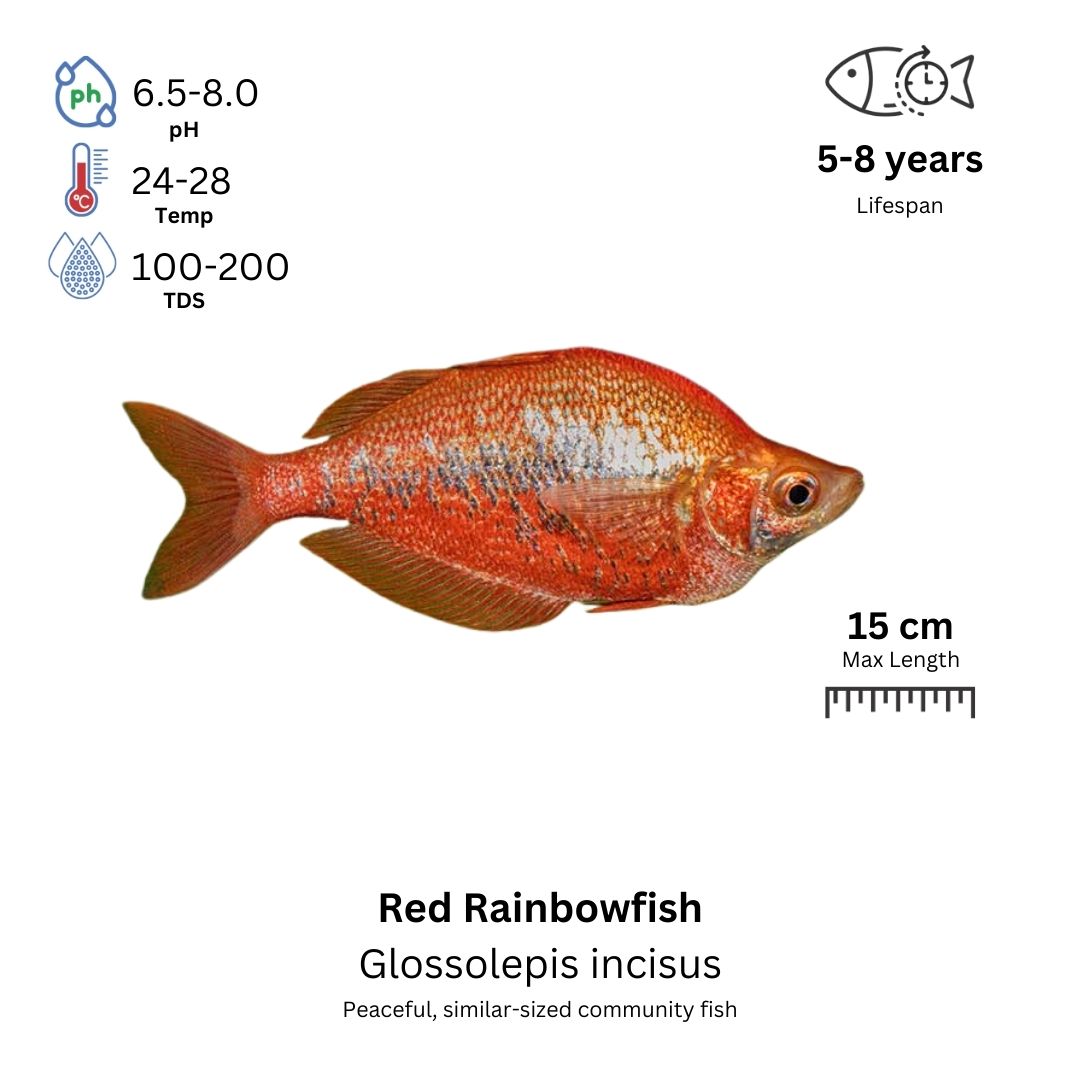Red Rainbowfish: A Guide for Aquarium Enthusiasts
The Red Rainbowfish (Glossolepis incisus), also known as the Salmon Red Rainbowfish, is a striking freshwater species renowned for its brilliant red coloration, torpedo-shaped body, and active schooling behavior. Native to Papua New Guinea, this species is a favorite among aquarists due to its vibrancy and peaceful nature, making it an excellent choice for large community tanks.
Characteristics
- Scientific Name: Glossolepis incisus
- Common Name: Red Rainbowfish, Salmon Red Rainbowfish
- Family: Melanotaeniidae
- Natural Habitat: Found in Lake Sentani, Papua New Guinea, in clear, slow-moving freshwater environments.
- Behavior: Peaceful, active schooling fish; best kept in groups of six or more.
- Tank Preferences: Prefers open swimming areas with plants along the edges.
- Ideal Water Parameters:
- pH: 6.5 – 8.0
- Hardness: Soft to moderately hard (8-15 dGH)
- Temperature: 24-28°C (75-82°F)
- Care Level: Moderate
Origin and Distribution
The Red Rainbowfish is endemic to Lake Sentani, Papua New Guinea, where it thrives in clear, oxygen-rich waters. Due to habitat degradation, wild populations are under pressure, making captive breeding essential to maintaining the species in the aquarium trade.
Colors and Markings
- Males: Develop an intense, deep red body color with an iridescent sheen.
- Females: More subdued in color, with silver or pale red tones.
- Fins: Semi-transparent with a slight orange or red tint.
- Juveniles: Start off with muted coloration and develop their red hues as they mature.
Tankmates
- Best Companions:
- Other Rainbowfish species (Boesemani, Celebes, or Australian Rainbowfish).
- Peaceful tetra species such as Rummy Nose Tetras and Cardinal Tetras.
- Bottom dwellers like Corydoras Catfish and Otocinclus.
- Avoid:
- Aggressive cichlids or fin-nipping species like Tiger Barbs.
- Slow-moving fish that may get outcompeted for food.
Care Requirements
- Tank Size: Minimum 40 gallons, but larger tanks (55+ gallons) are preferred for active swimming.
- Filtration: Strong biological filtration with moderate to high water flow.
- Water Changes: 25-30% weekly to maintain stable water quality.
- Lighting: Moderate to high; enhances their natural red coloration.
- Substrate & Plants:
- Dark sand or fine gravel helps accentuate their color.
- Live plants like Vallisneria, Java Fern, and Amazon Sword create a natural habitat.
Diet and Feeding
- Diet Type: Omnivore
- Food Recommendations:
- High-quality flake or pellet food rich in carotenoids to enhance red coloration.
- Live or frozen foods (brine shrimp, bloodworms, daphnia).
- Vegetable-based food (spirulina flakes, blanched spinach).
- Feeding Frequency: Twice a day in small portions.
Gender Differences
- Males: Larger, deeper red coloration, and more elongated dorsal and anal fins.
- Females: Smaller, less vibrant coloration, and a rounder body shape.
Breeding
- Difficulty: Moderate
- Breeding Requirements:
- Use spawning mops or dense plants like Java Moss for egg-laying.
- Maintain a slightly warmer temperature (26-27°C) to encourage spawning.
- Egg Laying & Hatching:
- Females scatter small adhesive eggs on plants.
- Eggs hatch in 7-10 days, and fry require infusoria or baby brine shrimp as their first food.
- Fry Care:
- Keep fry in a separate nursery tank for optimal survival.
- Provide gentle filtration and stable water conditions.
Additional Resources
If you enjoy Red Rainbowfish, you may also be interested in:
- Boesemani Rainbowfish – A stunning blue and yellow rainbowfish species.
- Celebes Rainbowfish – A smaller species with iridescent blue hues.
- Australian Rainbowfish – A hardy species with a mix of red, orange, and silver tones.




Reviews
There are no reviews yet.